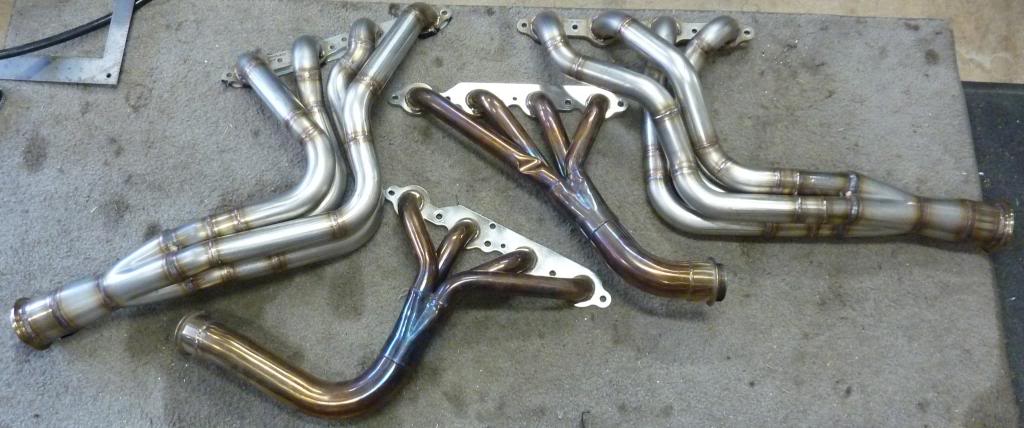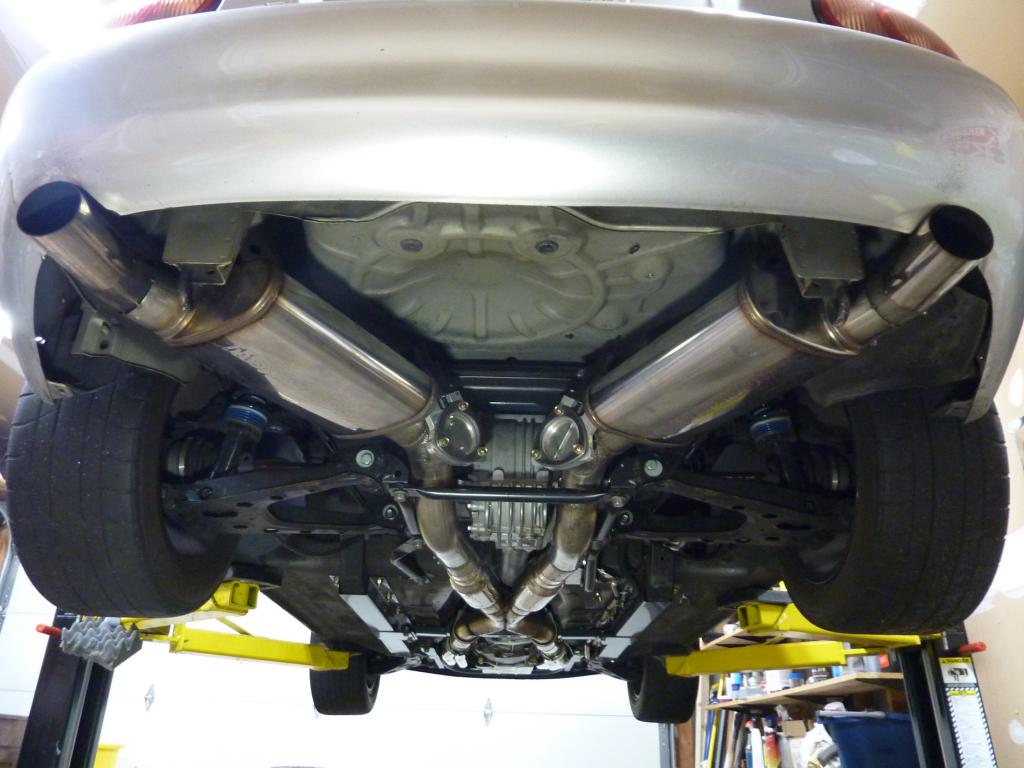Sanderson vs V8R long tube vs FM headers
#1
I have the small restrictive FM headers now and pushing 402 RWHP on my LS2 build. I am about to install some LS3 ported heads and intake and want to add better breathing headers. I know the V8R long tubes are good, but want to know the comparison to the Sanderson headers. I got a guy locally selling a new black ceramic coated set for 375, and want to know if anyone can compare against the $1000 V8R set.
The following users liked this post:
mazdaspeedmiata (06-29-2015)
#3
he switched to the FM shorties. which are still only 1.5" primaries. Only the V8R long tubes are 1.75" primaries, which is what I would recommend for a build using ls3 rectangular port heads.
The following users liked this post:
Gunpilot (06-30-2015)
#6
Ordered them last week with the v8 aluminum oil pan . Shipped quickly I'm going to get them Wednesday . I'll be test fitting in the next few weeks hopefully. I'll post the progress on the fit.
#7
Here's a dyno between FM and Custom 1- 7/8 headers. Guy did a fantastic job, saw them in person. Expect similar results with the V8R stuff, less a few ponies. I know there is another few dyno charts comparing long vs short, but can't find any at this time.
https://www.v8miata.net/v8-miata-dyn...266/#post15015
https://www.v8miata.net/v8-miata-dyn...266/#post15015
#8
I have done back to back. V8R headers were good for 18 hp and 23 ft. lbs. LS6 with mild cam and LS7 intake. Otherwise stock. Ended up at 396 rwhp and 387 lbs. ft
Last edited by sbwrench; 04-25-2016 at 07:29 PM. Reason: misspelling
#9
Interestingly, we didn't see any gain with the V8R long tubes over the FM parts. The "Q-Ship" build was built with a 525 crate engine, and it wasn't as strong as my own car with the 525 crate engine. 435 vs 466 whp, if memory serves. The rest of the exhaust was the same, no cats and the FM muffler.
#10
That's odd. I picked up 35hp/38tq by swapping to custom long tube headers and custom exhaust. Same dyno. Same tuner. No other modifications done to the car other than the exhaust system.
Again, this isn't the V8R headers or the FM exhaust, but the header design is VERY similar. I'm not saying that all of my power was gained by the header alone, but a well designed header (like V8R's) should definitely be a gain over any shorty header, assuming the necessary tuning is done.


Again, this isn't the V8R headers or the FM exhaust, but the header design is VERY similar. I'm not saying that all of my power was gained by the header alone, but a well designed header (like V8R's) should definitely be a gain over any shorty header, assuming the necessary tuning is done.


The following users liked this post:
charchri4 (06-03-2016)
#12
#14
#15
This is an piston engine aircraft engine related page ... they might know a little about the effects of altitude.
"It must be remembered that a 200Hp engine becomes a 130Hp engine at cruise altitudes of 8000-12,000 ft. Optimization of exhaust tuning at these altitudes, with the attendant reduced air density, will call for use of smaller diameter headers and collectors"
#16
Oh, we know a lot about the physics of dyno testing at altitude.
However, we found that the V8R long-tubes made less power than ours did even though there was an absolute 400 rwhp of air volume running through the system. Regardless of the decrease in gas volume, that's an indication that something's not right and you can't chalk it up to ambient pressure variations.
Or, look at it this way: if you're making 400 at the wheels at sea level, then a set of long tubes will cost you power according to our testing.
However, we found that the V8R long-tubes made less power than ours did even though there was an absolute 400 rwhp of air volume running through the system. Regardless of the decrease in gas volume, that's an indication that something's not right and you can't chalk it up to ambient pressure variations.
Or, look at it this way: if you're making 400 at the wheels at sea level, then a set of long tubes will cost you power according to our testing.
#17
I'm definitely not knocking the credibility of your testing, as I know you guys understand proper back-to-back testing methods, keeping consistent tuning, conditions, etc. But, do you have any theories for why the shorties made more power at around 400 rwhp? That is the opposite of what the general consensus is for the general LSx community. Is the V8r a flawed design? Is it too large for 400 rwhp and be better suited in a higher power application? Does the particular cam used come into play with which header design may be better?
#18
The cam will definitely have an effect on header design if you're really trying to eke out every last horsepower. Both of these cars had the GM ASA cam. But when working on the Miata engine, I've found that as long as you're in the ballpark you'll do well.
Has anyone else done a straight comparison with no other changes? Every one I've seen has always been done at the same time as a bunch of other modifications like a head change or a complete exhaust system change.
Has anyone else done a straight comparison with no other changes? Every one I've seen has always been done at the same time as a bunch of other modifications like a head change or a complete exhaust system change.
#20
I'm interested on where this thread goes as well. Because like aceduece was saying, it's pretty much common knowledge that LT headers are always good for gains. I can't fathom how your testing could show that V8R long tubes loose power over smaller diameter primaries and runners. To me that just doesn't make sense.
#21
It seems to be "common knowledge", but I'm not sure that's been based on A/B testing in Miatas. Kind of like it's "common knowledge" that NB upper mounts give more suspension travel, but measuring shows this isn't actually the case.
I will admit that this test was two different cars. Both the same crate engine - one a 525 crate, the other a 480 crate that had been fitted with the ASA cam. The only difference in the exhaust system other than that which was required to fit the long tubes was that the shorty car had no resonators. Resonators aren't terribly restrictive, of course. We have a third car built to very similar specs as mine and it also outperformed the long tube car, but not by as much. We're starting a fourth build now with the same engine, and it will also be on the dyno when the time comes. It'll be interesting to see.
Doing a back to back test on the same car would be expensive due to the effort involved in R&Ring the long tubes. Nobody's been willing to fund that to this point.
I will admit that this test was two different cars. Both the same crate engine - one a 525 crate, the other a 480 crate that had been fitted with the ASA cam. The only difference in the exhaust system other than that which was required to fit the long tubes was that the shorty car had no resonators. Resonators aren't terribly restrictive, of course. We have a third car built to very similar specs as mine and it also outperformed the long tube car, but not by as much. We're starting a fourth build now with the same engine, and it will also be on the dyno when the time comes. It'll be interesting to see.
Doing a back to back test on the same car would be expensive due to the effort involved in R&Ring the long tubes. Nobody's been willing to fund that to this point.
#22
It seems to be "common knowledge", but I'm not sure that's been based on A/B testing in Miatas. Kind of like it's "common knowledge" that NB upper mounts give more suspension travel, but measuring shows this isn't actually the case.
I will admit that this test was two different cars. Both the same crate engine - one a 525 crate, the other a 480 crate that had been fitted with the ASA cam. The only difference in the exhaust system other than that which was required to fit the long tubes was that the shorty car had no resonators. Resonators aren't terribly restrictive, of course. We have a third car built to very similar specs as mine and it also outperformed the long tube car, but not by as much. We're starting a fourth build now with the same engine, and it will also be on the dyno when the time comes. It'll be interesting to see.
Doing a back to back test on the same car would be expensive due to the effort involved in R&Ring the long tubes. Nobody's been willing to fund that to this point.
I will admit that this test was two different cars. Both the same crate engine - one a 525 crate, the other a 480 crate that had been fitted with the ASA cam. The only difference in the exhaust system other than that which was required to fit the long tubes was that the shorty car had no resonators. Resonators aren't terribly restrictive, of course. We have a third car built to very similar specs as mine and it also outperformed the long tube car, but not by as much. We're starting a fourth build now with the same engine, and it will also be on the dyno when the time comes. It'll be interesting to see.
Doing a back to back test on the same car would be expensive due to the effort involved in R&Ring the long tubes. Nobody's been willing to fund that to this point.
I say send me a set and ill compare stock ls2 with v8r vs fm post the results and ill send them back lol
#23
#25
were you using identical computers? slight differences can have big effects.. I am very curious in these results as well cause every testing I've seen shows the ls loves the longtubes everytime. and just the different size in primary's should have some effect. as hot rod just showed a 600hp engine with 2.5" exhaust vs 3" with a 20hp difference in power levels.
I say send me a set and ill compare stock ls2 with v8r vs fm post the results and ill send them back lol
I say send me a set and ill compare stock ls2 with v8r vs fm post the results and ill send them back lol
We have found that my engine is the dyno king. It's got an ASA cam that was installed after the original engine build (at about 50 miles, replacing a Hot Cam) instead of showing up that way as a crate, so there's some theories that the cam you get separately (with the same part number) is not identical to the ones in the engine.
What can I say, it's not a popular dyno result and one that "everybody knows" is wrong. But it's what the lie detector said.










